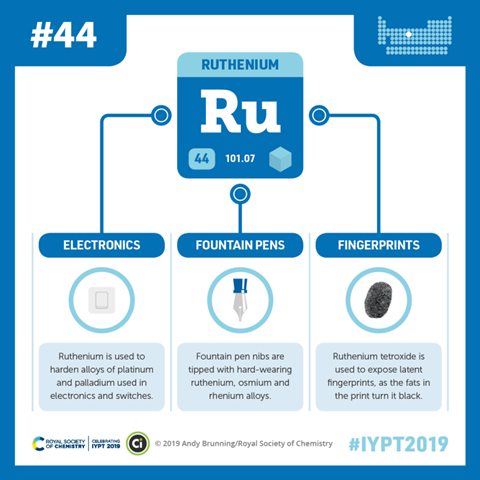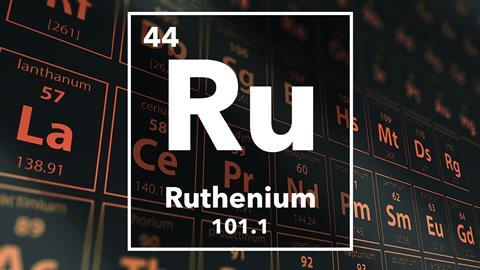Chris Smith
Hello, welcome to this week's Chemistry in its element, I'm Chris Smith. In this episode we come face to face with the chemical dubbed the connoisseur's element. It's won a nobel prize as a catalyst, it's the muscle behind wear resistant electrical contacts and it might even help you to write nicely, unless you're a doctor, in which case you're probably beyond redemption. Here's Jonathan Steed.
Jonathan Steed
Stop the proverbial 'man in the street' and ask him what ruthenium is and the chances are he won't be able to tell you. Compared to the 'sexier elements' that are household names like carbon and oxygen, ruthenium is, frankly, a bit obscure.
In fact even if your man in the street was wearing a lab coat and walking on a street very close to a university chemistry department he might still be a bit ignorant about this mysterious metal. It wasn't always that way, though. Twenty or thirty years ago whole generations of chemists did entire Ph.D.s on the chemistry of the metals of the so-called 'platinum group' of which ruthenium is one. As one of that cohort of ruthenium chemists it is my duty to spread the word about the element once described by one of the fathers of modern inorganic chemistry, Sir Geoffrey Wilkinson as 'an element for the connoisseur'.
As I rustily recalled in response to the first question I was asked in my Ph.D. exam, the name 'ruthenium' derives from Ruthenia, the Latin word for Rus', a historical area which includes present-day western Russia, Ukraine, Belarus, and parts of Slovakia and Poland. The name was first proposed by Gottfried Osann in 1828, who believed he had identified the metal, and the name was retained by Osann's countryman (and in 1844 ruthenium's official discoverer) Karl Klaus in honour of his birthplace in Tartu, Estonia; at the time a part of the Russian Empire.

Ruthenium's popularity in university chemistry departments in the latter half of the twentieth century was in no small part due to the fact that it is relatively cheap. The rarity of the platinum group metals (which are often found together) makes them all expensive but unlike platinum, rhodium and palladium which have use in automobile catalytic converters, for example, ruthenium was historically not so much in demand. Indeed for many years the metals company Johnson Matthey operated a loan scheme where they would give aspiring researchers 100 g or so of ruthenium trichloride to experiment with in the hope the chemists would find new uses for the material. The loans scheme operated for the pricier metals like rhodium as well, but only in little 5 g pots. A nice feature of the loans scheme was that chemists collected the metal-containing residues of their experiments and returned the resulting black, smelly sludge to the company for metals recovery.
So, from the 1960s onwards when the field of organometallic chemistry burst onto chemists' consciousness, a lot of people were doing a lot of research with the connoisseur's element. While it was a rhodium reaction that led the ever colourful Wilkinson to rush around his lab brandishing a foaming test tube and shouting 'who wants a Ph.D.?', it certainly seemed true that Ph.Ds. were to be had for nothing more than boiling up any of the platinum group metals with as many organic materials as possible and analyzing the fascinating cornucopia of compounds that resulted.
It turns out that ruthenium does indeed deserve Wilkinson's elegant description. While the element itself is an unremarkable looking, rather hard, white metal it forms a vast range of interesting compounds that seem to have that perfect balance between reactivity and stability to make them generally useful but easy to handle. Like all of the platinum group metals, ruthenium complexes are good catalysts.
Wind the clock forward to 2005, when Yves Chauvin, Bob Grubbs and Dick Schrock were awarded the Nobel prize in chemistry 'for the development of the metathesis method in organic synthesis'; this synthetic chemistry award was a real boost for the 'pot boilers'. And which of the platinum group metals is it that lies at the heart of Grubbs' elegant catalyst system for this fantastically useful, modern carbon-carbon bond forming reaction? It turns out that it is a cool carbene complex of the humble ruthenium that gets it just right.
It is this kind of niche application – just a little in the just the right place that I think Wilkinson was talking about. In fact, the harder you look the more you find just little bits of ruthenium stiffening the backbone of technology. Due to its hardness ruthenium is used in alloys with other platinum group metals to make wear-resistant electrical contacts, and there is a vast amount of interest in ruthenium-based thin film microelectronics because the metal can be easily patterned.

If you are fan of fountain pens then the chances are you have written with a ruthenium alloy. The famous Parker 51 fountain pen has been fitted with an 'RU' nib since 1944; a 14K gold nib tipped with 96.2% ruthenium and 3.8% iridium. Ruthenium compounds also have some nice optical and electronic properties. Like its lighter close relative, iron, ruthenium readily forms a number of oxides including some exotic oxygen bridged multi metallic compounds. One such material, ruthenium red, is a dye used to stain negatively charged biomolecules such as nucleic acids in microscopy. Ruthenium complexes also have significant potential as anti-cancer treatments.
One of my personal favourites in the zoo of exotic ruthenium complexes is the Creutz-Taube ion – two ruthenium atoms surrounded by ammonia molecules and joined by a molecule of pyrazene (imagine benzene but with a couple of nitrogen atoms). This was the first genuinely delocalized mixed valence complex. From the overall charge you know that one of the ruthenium ions has to have a +3 charge and one has to have +2 but there's just no way to work out which is which. It behaves for all the world as if the two metals have plus two and a half charges each even though charges only come in units of one! This compound gave rise to a whole field of 'mixed valence' chemistry and is part of the tremendously exciting field of molecular electronics today.
So, when you think about chemistry and are watching yet another documentary on the vital importance of carbon, or the hydrogen economy, spare a thought for the rare, refined elements like ruthenium that are reserved only for the connoisseur.
Chris Smith
So that's why I can't read my own writing – perhaps Bic need to start incorporating some ruthenium in their roller balls. That was Durham University's Jonathan Steed. Next time to the stuff that's the bain of kettles and boilers everywhere – but there are some benefits too.
Karen Faulds
The calcium usually enters the water as it flows past either calcium carbonate, from limestone and chalk, or calcium sulfate, from other mineral deposits. Whilst some people do not like the taste, hard water is generally not harmful to your health. Although it does make your kettle furry! Interestingly, the taste of beer (something dear to my heart) seems related to the calcium concentration of the water used, and it is claimed that good beer should have a calcium concentration that is higher than that of hard tap water.
Chris Smith
And more importantly an alcohol concentration of at least 10%. No southern softies around here, thank you very much. Karen Faulds will be serving up the story of Calcium on next week's Chemistry in its element. I'm Chris Smith, thank you very much for listening and goodbye.













No comments yet